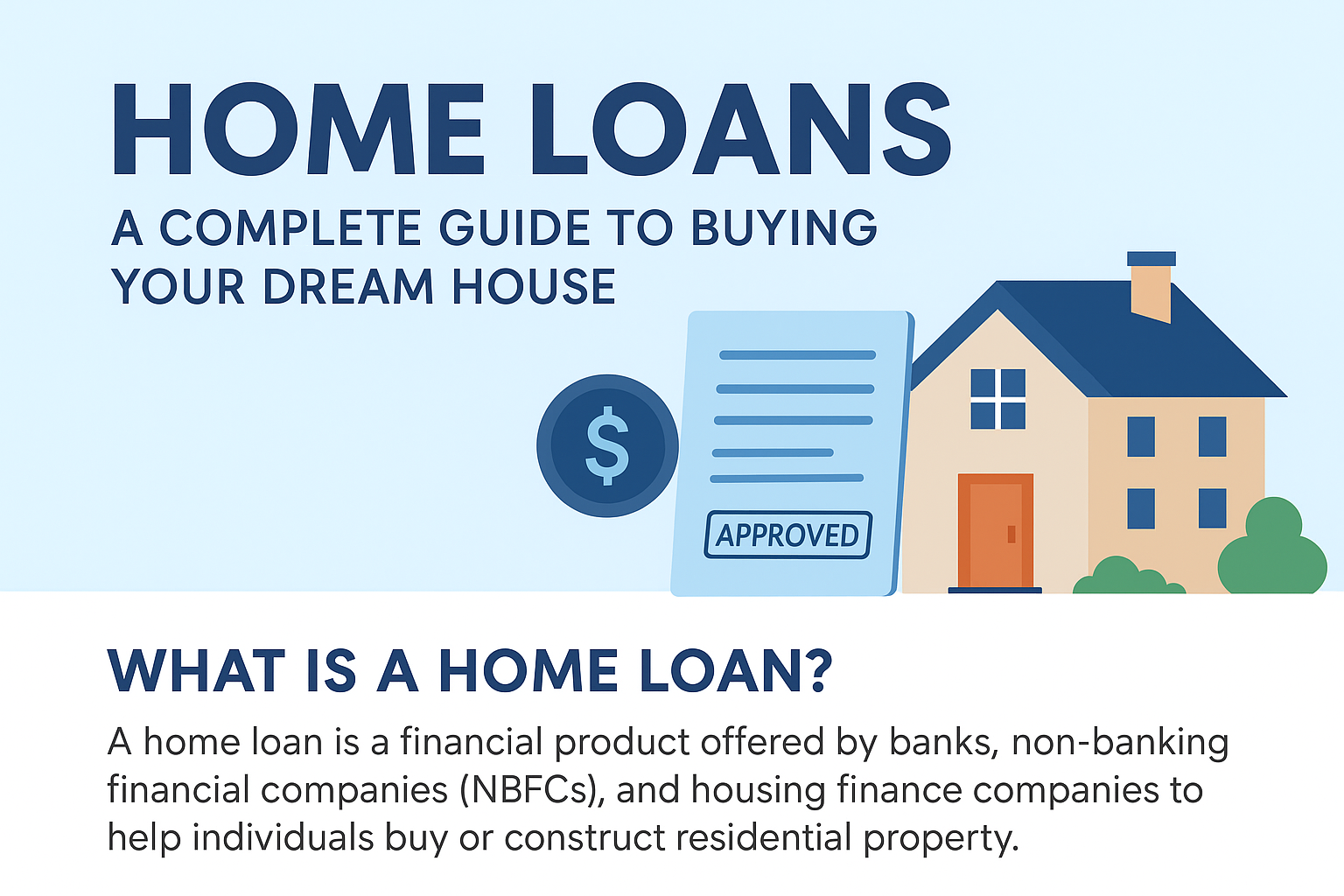Owning a home is one of life’s biggest milestones, but for most people, buying a house outright isn’t financially possible. That’s where credit score based loan options like home loans come in. A home loan, or mortgage, helps you purchase, construct, or renovate your house while repaying the borrowed amount over time in easy installments.
In this guide, we’ll explore everything about home loans — how they work, types, eligibility criteria, benefits, risks, and smart tips to get the best home loan deals.
What Is a Home Loan?
A home loan is a financial product offered by banks, non-banking financial companies (NBFCs), and housing finance companies to help individuals buy or construct residential property.
The lender provides funds, and the borrower agrees to repay the loan over a fixed period (called tenure) through EMIs — Equated Monthly Installments — which include both principal and interest.
How Home Loans Work
Home loans are usually secured loans, meaning your property acts as collateral. If you fail to repay the loan, the lender can auction the property to recover their money.
Key Components of a Home Loan:
-
Loan Amount (Principal): The amount borrowed from the lender.
-
Interest Rate: The cost of borrowing, expressed as a percentage.
-
Loan Tenure: Duration of repayment, typically 10–30 years.
-
EMI: A fixed monthly payment including principal and interest.
-
Down Payment: A portion of the property’s price paid upfront.
Types of Home Loans
-
Home Purchase Loan
-
For buying a new or resale property.
-
Covers 75%–90% of the property’s cost depending on eligibility.
-
-
Home Construction Loan
-
For building a house on your own land.
-
Funds disbursed in phases based on construction progress.
-
-
Home Renovation Loan
-
For upgrading or remodeling an existing house.
-
Covers painting, flooring, kitchen upgrades, and more.
-
-
Home Extension Loan
-
To add more space — e.g., extra room or another floor.
-
-
Balance Transfer Loan
-
Transfer your home loan to another lender offering lower interest rates.
-
-
NRI Home Loans
-
Specifically for Non-Resident Indians investing in property back home.
-
Home Loan Eligibility Criteria
Before approving a loan, lenders assess your repayment capacity. Common factors include:
-
Age: Usually 21–65 years.
-
Income: Higher income improves eligibility.
-
Employment Type: Salaried individuals get easier approvals than self-employed borrowers.
-
Credit Score: 700+ generally helps secure better interest rates.
-
Existing Liabilities: Lower debt-to-income ratios improve approval chances.
Documents Required for a Home Loan
-
Identity Proof: Aadhaar, passport, PAN card, or driving license.
-
Address Proof: Utility bills, rental agreements, etc.
-
Income Proof: Salary slips, bank statements, ITR filings.
-
Property Documents: Sale agreement, title deed, allotment letter.
-
Photographs: Passport-size photos of the applicant and co-applicant.
Home Loan Interest Rates
Interest rates depend on credit profile, property value, and lender policies.
| Type of Interest | Description |
|---|---|
| Fixed Interest Rate | Stays the same throughout the loan tenure. |
| Floating Interest Rate | Varies based on market conditions; can be cheaper in the long run. |
Pro Tip: Compare rates from multiple lenders before finalizing a loan.
Benefits of Taking a Home Loan
-
Makes Homeownership Affordable – Repay gradually through EMIs instead of paying full price upfront.
-
Tax Benefits – Deductions on principal repayment and interest under specific sections of the Income Tax Act.
-
Builds an Asset – EMIs contribute to owning a property, an appreciating asset.
-
Lower Interest Rates – Usually lower than personal or business loans.
-
Long Repayment Tenure – Up to 30 years to make EMIs manageable.
Risks of Taking a Home Loan
-
Long-Term Commitment: 15–30 years of repayment can strain finances.
-
Default Risk: Missing EMIs hurts credit score and may lead to property seizure.
-
Hidden Charges: Processing fees, prepayment penalties, and legal charges.
-
Floating Rates Fluctuation: EMIs may increase if market interest rises.
Tips to Get the Best Home Loan Deal
-
Improve Your Credit Score – Higher scores lead to lower interest rates.
-
Compare Multiple Lenders – Evaluate rates, EMIs, and hidden charges.
-
Opt for Pre-Approved Offers – Minimal documentation for existing customers.
-
Choose a Shorter Tenure – Reduces overall interest paid.
-
Negotiate Interest Rates – Ask for better terms with a strong financial profile.
-
Consider a Balance Transfer – Lower EMI burden with cheaper interest rates.
Home Loan EMI Calculator
Estimate monthly installments with this formula:
EMI=P×R×(1+R)N(1+R)N−1EMI = P \times R \times \frac{(1+R)^N}{(1+R)^N – 1}
Where:
-
P = Loan Amount
-
R = Monthly Interest Rate
-
N = Number of EMIs
Example:
A $100,000 home loan at 7% annual interest over 20 years → EMI ≈ $775.
Home Loan Myths vs. Reality
| Myth | Reality |
|---|---|
| “Renting is cheaper than buying.” | Buying builds long-term wealth; renting doesn’t. |
| “Home loans are only for the rich.” | Loans now available for a wide range of incomes. |
| “Fixed rates are always better.” | Floating rates can save money when interest trends are low. |
| “Prepaying always has penalties.” | Many lenders allow free or low-cost prepayments. |
Future of Home Financing
-
Digital Approvals: Instant approvals through online portals.
-
AI-Powered Risk Assessment: Smarter credit evaluation with minimal paperwork.
-
Government Subsidies: Affordable housing schemes for first-time buyers.
-
Green Home Loans: Lower interest for eco-friendly projects.
Final Thoughts
A home loan is more than borrowing money — it’s a gateway to owning your dream home. By understanding options, comparing lenders, and planning repayments, you can make smart financial decisions.
Choose the right loan, calculate EMIs carefully, and maintain financial discipline. With the right approach, your dream home is well within reach.
